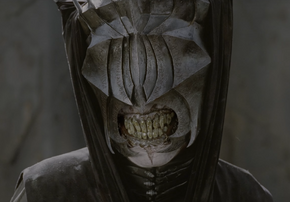| Mouth of Sauron | |
| Tolkien character | |
 | |
| First appearance | The Return of the King |
| Information | |
|---|---|
| Aliases | Lieutenant of Barad-dûr Messenger of Mordor |
| Species | Men (Black Númenóreans) |
The Mouth of Sauron is a fictional character in J. R. R. Tolkien's Middle-earth legendarium. He appears in The Lord of the Rings — specifically in the chapter "The Black Gate Opens" in the third volume, The Return of the King — as the chief emissary of Sauron.
Described as "no Ringwraith but a living man", he belonged to the race of the Black Númenóreans. He appeared before the Black Gate to haggle with the Army of the West, suggesting to Aragorn and Gandalf that the fight against Sauron was hopeless. Gandalf turned his proposal down, and the Mouth of Sauron set the armies of Mordor to Battle of the Morannon|attack.
Also known as the Lieutenant of Barad-dûr, he had served Sauron for much of his life, learning great sorcery but forgetting his own name. As the Mouth of Sauron, "he entered the service of the Dark Tower when it first rose again". There is some dispute over the length of time this implies. If it refers to Sauron's most recent return to Mordor, the Mouth of Sauron would have served Sauron for some 68 years when he encountered Aragorn and Gandalf.
Concept and creation
The appearance and the arrogance of the Mouth of Sauron before the Army of the West has been described as showing Biblical influences. The character matches the description of the False Prophet in the Book of Revelation, speaking arrogant words and blasphemies, and is reminiscent of Saint Paul's comments in the Second Epistle to the Corinthians where he describes his public humiliation by the enemy.
Gandalf's refusal to negotiate with the Mouth, a mere emissary of Sauron, has been seen as an echo of Churchill's position in World War II, while the Mouth's offer of a peace in slavery has been compared to Vichy France under German occupation.
In adaptations
The Mouth of Sauron appears in the 1980 animated version of The Return of the King and was voiced by Don Messick. He rides out briefly with a single companion and, in a departure from the book, does not mention Frodo, but merely informs Aragorn that his army is outnumbered.
The Mouth of Sauron also appears in the extended edition of The Lord of the Rings: The Return of the King (2003), where he is played by Bruce Spence. Director Peter Jackson cut the Mouth from the theatrical version, believing the scene lacked effect. (Due to intercutting Frodo and Aragorn's narratives in chronological order, the movie audience, unlike book readers, would know the Mouth is lying about Frodo being dead.) He had originally planned to cast Kate Winslet in the role to suggest temptation, but chose instead to make the character diseased and disfigured. Spence is virtually unrecognizable: a helmet covers his entire face except the mouth, which is digitally increased to disproportionate size and disfigured by blackened, cracked lips and rotting teeth.
According to the DVD commentary, the idea behind this is that simply repeating Sauron's messages has such an evil effect that it has warped his body. Unlike the book, where he sought to secure Aragorn's surrender by claiming that Frodo was captive in Mordor, the Mouth in the film attempts to instill despair by claiming that Frodo died under torture. In another departure from the book, Aragorn decapitates the Mouth with his sword Andúril.
The Mouth is also featured in EA Games' The Lord of the Rings: The Return of the King video game, and Warner Brothers' The Lord of the Rings: Aragorn's Quest as a boss character the player must defeat. In both games, he appears in the level "The Black Gate". He is also a playable villain in The Lord of the Rings: The Battle for Middle-earth II, The Lord of the Rings: The Third Age (GBA), The Lord of the Rings: Conquest, and Lego The Lord of the Rings: The Video Game.